Kids Corner
Kids Corner.
Where you can learn about the solar system, planets and everything in between, all while having fun with our interactive quizes, puzzles and games.
Welcome to our kids corner, where people of all ages can learn about our solar system and other fun space stuff and even play some games!
Amazing Fun Space Facts

Our Solar System
Our solar system is in one of the spiral arms of the Milky Way galaxy and has 8 planets, some of which are made of rock and some are made of gas. It used to have 9 as Pluto was originally classed as a planet for 76 years but has now been downgraded to a dwarf planet.
Our solar system also has an immense asteroid belt between Mars and Jupiter, which houses a vast amount of asteroids also known as minor planets. There are 5 officially classed dwarf planets: Ceres, Pluto, Haumea, Makemake and Eris. We have 181 known moons in our solar system orbiting the various planets and dwarf planets. Of the 13 planets and dwarf planets, there are 4 which don’t have any moons. These are the planets Mercury and Venus and the dwarf planets Ceres and Makemake.
Nasa; The North American Space Agency sent a rhesus monkey called Albert II into space in 1949 after a failed first attempt in the early 40s. Unfortunately Albert II didn’t make it back to Earth alive but did reach 83 miles into space. After that, there were alot more failed attempts (not reaching high enough altitude to be classed as space flight) by America and Russia sending more monkeys and mice than ever before. In 1957, Russia sent Laika the dog into space and he became the first animal to actually orbit the Earth which paved the way for human space exploration so in 1969 America sent Neil Armstrong, Buzz Aldrin and Micheal Collins to the moon in Apollo 11. Neil Armstrong was the first man to step on the moon and was televised live doing so while saying ” One small step for man, one giant leap for mankind”, he then planted an American flag which was left on the moon.
The Planets In Our System
The planets in order closest to the sun moving away are: Mercury > Venus > Earth > Mars > Jupiter > Saturn > Uranus > Neptune. We’ll delve deeper into each individual planet and learn some weird, wonderful and interesting facts.
Here’s a little rhyme to help you remember the order of the planets!
My Very Excellent Mum Just Served Us Nine pies…
My Very Easy Method Just Saved Us Naming planets….
Mercury

Mercury is the smallest of the 8 planets, it’s only just bigger than Earth’s moon. It’s the closest to the sun but surprisingly is not the hottest!
Mercury only takes 88 Earth days to orbit the sun but yet a day on Mercury is 59 Earth days. For us, the sun rises and sets each and every day but because Mercury has a slow spin and short year, it takes a long time for the sun to rise and set there and as that result it only has one sunrise every 180 Earth days! Isn’t that weird?
Mercury has no moon and no real atmosphere. It’s a terrestrial planet which means it’s made of rock. It has been known to us since ancient times as it can be seen without an advanced telescope and has been visited by 2 spacecrafts: Mariner 10 and Messenger.
Venus

Venus may not be the closest to the sun but it sure is the hottest! It’s the second largest terrestrial planet with an extremely thick atmosphere which means it traps the heat from the sun which is why it is the hottest. It has a very active surface including volcanoes…. Just like it’s neighbour, Venus doesn’t have any moons and can be seen from Earth without the need of an advanced telescope.
Venus spins in the opposite direction to Earth and most of the other planets, a day on Venus is 243 Earth days but a year is 225 Earth days. It also has had lots of visits from spacecrafts over the years including: Mariner 2, Mariner 5, Mariner 10, Venus 1, Venus 2 and an orbiter called Magellan.
Earth

Earth is the third planet from the sun and the largest of terrestrial planets in our system. It has just the right thickness of atmosphere to keep our lovely little planet at the right temperature, as far as we know, Earth is the only planet capable of supporting life, it is mostly nitrogen but has plenty of oxygen for us to breathe.
Earth can do one full axis rotation in 24 hours, known as one day and one full sun orbit takes 365 days, known as one year.
Earth only has 1 moon which we can see almost every night and we can even see it go through it’s full lunar cycle which takes around 29 days, the lunar cycle affects the tides on Earth and determines when high and low tide will be and if that wasn’t impressive enough it also controls our seasons!
Mars

Mars is the second smallest planet and the last of the terrestrial planets. It is well known as the “red planet” because of it’s reddish brown colour. Just like Earth, it has seasons, polar ice caps, volcanoes (although they are all dead) and weather. It’s atmosphere is very thin and made up of carbon dioxide, nitrogen and argon.
Scientists are looking into finding out whether Mars could support life now or in the future but have so far got no conclusive answers. Several missions have visited Mars, it is the only planet we have sent rovers to which drive around taking pictures and measurements.
Mars has 2 moons called Phobos and Deimos. A day on Mars is 25 hours but a year is 687 Earth days.
Jupiter

Jupiter is the largest planet in our system, it would take 11 Earths side by side to cover the full diameter of Jupiter (wow!). It is a gas planet made up of hydrogen and helium, with what is thought to be a solid inner core the size of 1 Earth. The atmosphere here is extremely thick and it does actually have rings but they are so very faint the can’t be seen.
Jupiter has 79 moons surrounding it and an asteroid belt between it and Mars. One full day on Jupiter is only 10 hours but a full year is nearly 12 Earth years….. figure that one!….
Jupiter has been visited or passed by several spacecrafts, orbiters and probes such as Pioneer 10 and 11, Voyager 1 and 2, Cassini, New Horizons, and Juno.
Saturn
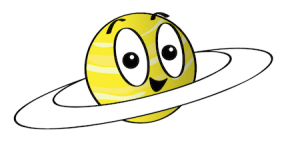
Saturn is the second largest planet and is known as Jupiter’s relative. It is a gas planet with a thick atmosphere, made up of mostly hydrogen and helium but it’s beautiful set of 7 main rings with spaces between them, are made of ice and rock.
Saturn has 53 confirmed moons and a further 29 unconfirmed moons making that a total of 82 moons!
One full day on Saturn is just 11 hours but one full year is 29 Earth years….wowzers!!
4 robotic spacecrafts have visited Saturn; Pioneer 11, Cassini, and Voyager 1 and 2.
Uranus

Uranus is made of water, methane, and ammonia fluids above a small rocky center. It’s atmosphere is made of hydrogen and helium but it also has methane which makes Uranus blue.
Uranus has a set of 13 faint rings and like Venus rotates in the opposite direction to Earth and most other planets with one added quirk, it also rotates sideways which means one full day is 17 hours long but a full year is 84 Earth years (Holy moly!)
Uranus has 27 moons and was first discovered by William Herschel from the UK in 1781 and has only ever been visited by 1 spacecraft: Voyager 2.
Neptune

Neptune is the last of our known planets, it is 30 times further away from the sun than Earth is, making it extremely dark, cold and windy. Neptune is very similar to Uranus, it’s made of a thick fog of water, ammonia, and methane over an Earth-sized solid center. It’s atmosphere is made of hydrogen, helium, and methane, which again gives it the same blue colour as Uranus. Neptune has six rings but they’re very hard to see.
One day on Neptune is 16 hours but one year takes 165 Earth years because of how far away it is from the sun.
Neptune has 13 moons and was first discovered by Urbain Le Verrier, John Couch Adams, and Johann Galle in 1846 and again has only been visited by the spacecraft Voyager 2.
Constellations And Stars
The Constellations
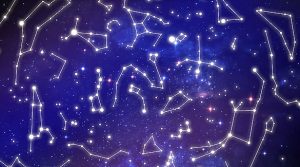
Aries, Aquarius, Cancer, Capricorn, Gemini, Leo, Libra, Pisces, Sagittarius, Scorpio, Taurus, Virgo are the 12 zodiac constellations but 2 other famous ones are Orion and Ursa Major (The Big Dipper).
Aries


Aries has three prominent stars forming an asterism – Alpha, Beta and Gamma Arietis, all of which have been traditionally used for navigation. Alpha Arietis, called Hamal, is an orange giant with an apparent magnitude of 2.0, making it the brightest star in the constellation.
Aries is also home to several faint Deep Sky Objects. These include NGC 772, an unbarred spiral galaxy located 130 million light-years from Earth which is visible to the southeast of Beta Arietis. It has a small companion galaxy, NGC 770, that is about 113,000 light-years away from the larger galaxy. Another spiral galaxy in Aries is NGC 673, a weakly barred spiral galaxy that is 235 million light-years distant from Earth.
It is also home to several meteor showers. The May Arietids are a daylight meteor shower which begins between May 4th and June 6th with maximum activity happening on May 16th. The Epsilon Arietids are also a daylight occurrence, which are active between April 25th to May 27th with peak activity on May 9th. The very best daytime Arietids occur from May 22nd to July 2nd with a maximum on June 8th, when the meteoroid stream produces one meteor every minute.
Aquarius


Despite its prominent position in the zodiac, Aquarius doesn’t have any particularly bright stars. In fact, its four brightest stars are all less than magnitude 2. It’s second brightest, Alpha Aquarii is a yellow supergiant named in Arabic for the phrase “the lucky stars of the king”. This star has a magnitude of 2.94 (though it has an absolute magnitude of -4.5) and is located 523 light years from Earth. The brightest star is Beta Aquarii (aka. Sadalsuud), a yellow supergiant that takes its name from the Arabic phrase that means “luckiest of the lucky stars.” This star is located 537 light years from Earth, and has an apparent magnitude of 2.89 and an absolute magnitude of -4.5.
Aquarius is also home to several Deep Sky Objects. Because of its position away from the galactic plane, the majority of these take the form of galaxies, globular clusters and planetary nebulae. These include M2 (NGC 7089), one of the largest globular clusters in the Milky Way, located about 33,000 light years from Earth. M72 also calls Aquarius its home, a globular cluster located roughly 55,000 light years away and so does M73, an open cluster 2,500 light years from Earth. 2 well-known planetary nebulae are also located in Aquarius, including NGC 7009 and the famous NGC 7293.
Cancer


Though comparatively faint, the Cancer constellation contains several notable stars. For starters, there is Beta Cancri, which is also known by the Arabic name of Al Tarf (“the eye” or “the glance”). Beta Cancri is the brightest star in Cancer and is about 660 times brighter than our Sun. This K-class orange giant star is about 290 light years away from Earth, and is part of a binary system (2 stars) that includes a 14 magnitude star. This second star is so far away – about 65 times the distance of Pluto from the Sun – that their orbital period is at least 76,000 years! Then there is Delta Cancri – an orange giant star approximately 180 light-years away. This is the second-brightest star in the Cancer constellation, and also where the famous Beehive Cluster (M 44)
Cancer is also home to many Deep Sky Objects. So far, eleven white dwarfs have been identified. Then there’s M67, which can be viewed due west of Alpha Cancri. M67 is not the oldest known galactic cluster, but there are very few in the Milky Way known to be older. M67 is an important laboratory for studying stellar evolution, since all its stars are at the same distance and age, except for approximately 30 anomalous blue stragglers, whose origins are not fully understood. There’s also NGC 2775, which is positioned some 60 million light years away. NGC 2775 is a peculiar blend of spiral galaxy with a smooth bulge in the center. The star formation is confined to this ring of tightly wound arms, and the galaxy has been the location of 5 supernovae explosions in the past 30 years!
Capricorn


In terms of stars, there are few bright ones. It’s brightest star is also not its primary but Delta Capricorni. Also known as its traditional names Deneb Algedi and Sheddi (from the Arabic danab al-jady, “the tail of the goat”), this magnitude 2.85 star is actually a four-star system located approximately 39 light years from Earth. Its brightest star (Delta Capricorni A) being a white giant with a luminosity 8.5 times that of the Sun. It’s second brightest star, Beta Capricorni, is also known by the traditional name Dabih – which comes from the Arabic al-dhibii (which means “the butcher”), located 328 light years away. This star system consists of Dabih Major (Beta-1) and Dabih Minor (Beta-2); both of which is actually composed of multiple stars – Beta-1 is composed of a three stars while Beta-2 is a double star. It’s primary star, Alpha Capricorni, is also known as Algiedi, which is derived from the Arabic al-jady (“the billy goat”.) It is composed of two star systems, Prima Giedi (Alpha-2 Capricorni) and Secunda Giedi (Alpha-2 Capricorni); the former being a double star located 690 light-years away, and the latter is a yellow giant 109 light years away.
The only Deep Sky Object associated with this constellation is M30, a globular cluster located approximately 28,000 light years from Earth. This cluster is currently approaching us at a speed of about 112mph and was one of the first Deep Sky Objects discovered by Charles Messier in 1764
Gemini


Gemini is positioned on the ecliptic plane between between Taurus and Cancer. Only its Alpha and Beta stars – Castor and Pollux – are easy to recognize. They represent the “Twins”. Gemini is one of the original 48 constellations charted by Ptolemy. It contains 17 main stars in the asterism with 80 stars possessing Bayer/Flamsteed designations.
There are two annual meteor showers associated with the constellation of Gemini. The first peaks on or around the date of March 22 and are referred to as the March Geminids. This meteor shower was first discovered in 1973 and then confirmed in 1975. The second meteor shower associated with Gemini are the Geminids themselves which peak on or near December 14th, with activity beginning up to two weeks prior and lasting several days beyond the date. The Geminids are one of the most hauntingly beautiful and mysterious displays of celestial fireworks all year. First noticed in 1862 by Robert P. Greg of the UK and B. V. Marsh and Prof. Alex C. Twining of the USA in independent studies.
Gemini has lots to offer in terms of deep sky objects. NGC 2392 better known as the Eskimo Nebula, is a planetary nebula and has a bright central region and a surrounding dim ring structure. Be sure to up the magnification in even a small telescope on this one. Then there is NGC 2266. This open cluster is probably a billion years old, nearly all of its members evolved to the red giant star phase. From its position high above the galactic plane, low metallicity NGC 2266 has escaped the mixing of dusts and gases contained in the rest of the Milky Way and become the perfect laboratory for studying stellar evolution. Look for a relatively well compressed area of looping faint stars with a combined magnitude of near 10. NGC 2420 is another target, this near 8 magnitude galactic star cluster is rich in solar type stars, another scientific playground for learning about the origins and evolution of the Milky Way. With nearly 1000 stars packed densely together in a small region, NGC 2420 originally belonged to another small galaxy that was cannibalized by our own. With an estimated age of 1.7 billion years old, it remains a curiosity because it is moving rapidly through space.
Leo


Leo spans 947 square degrees of sky and is the 12th largest. It contains 3 bright stars and around 15 stars in its asterism, with 92 Bayer/Flamsteed designated stars within its confines. It is bordered by the constellations of Ursa Major and Leo Minor.
There are 5 annual meteor showers associated with Leo. The 1st is the Delta Leonid meteor stream which begins becoming active between February 5 through March 19 every year. The 2nd date is April 17 and the Sigma Leonid meteor shower. It is a very weak shower and activity rates no higher than 1 to 2 meteors per hour. The 3rd is the most dependable shower of all, the November Leonids. The peak date is November 17th but activity occurs around 2 days on either side of this date. The radiant is near Regulus and this is the most spectacular of modern showers. The last is the Leo Minorids which peak on or around December 14. This meteor shower was discovered by amateurs in 1971 and hasn’t really been confirmed yet.
Leo has plenty of deep sky object too with the M96 galaxy group being among them. M96 is the brightest spiral galaxy within the M96 Group which includes M95 and M105 as well as at least 9 other galaxies. Located about 38 million light years away. While you can’t expect to see each member in small optics, larger telescopes can hope to find elliptical galaxies NGC 3489, NGC 3412, NGC 3384 and NGC 3377, as well as barred spiral galaxy NGC 3299. For an awesome spiral galaxy in a small telescope, don’t overlook NGC 2903, at a bright magnitude 9, you can often see this particular galaxy in binoculars from a dark sky site as well. Discovered by William Herschel in 1784, this beauty is often considered a missing Messier because it is just so bright and conspicuous. As a matter of fact, the comet of 1760 passed it on a night Messier was watching and he didn’t even see it! You must stop by NGC 3521. This 35 million light year distant spiral galaxy is often overlooked for no apparent reason but it shouldn’t be. At a very respectable magnitude 9, you can often find this elongated gem with the bright nucleus in larger binoculars from a dark sky site and you can easily study spiral galaxy structure with a larger telescope.
Libra


Libra covers approximately 538 square degrees of sky and contains 6 stars in its asterism but none are of note worthy. There are 46 Bayer Flamsteed designated stars within Libra and it is bordered by Serpens Caput, Virgo, Hydra, Centaurus, Lupus, Scorpius and Ophiuchus.
The deep sky objects in Libra are quite few and far between. NGC 5694, is 10 magnitude, irregularly shaped globular cluster discovered by Sir William Herschel in 1784 and is one of the more remote globular clusters of the Milky Way Galaxy at a distance of about 113 thousand light years. Its brightest stars average about magnitude 16 and so far none of them have been discovered to be variable. NGC5792 at around magnitude 12, it’s going to take some dark sky to catch this nearly edge on spiral galaxy but it is worth your time and trouble. As part of the Herschel catalog, you’ll find a distracting star on the western edge, but very pretty spiral galaxy structure with a bright nucleus await you. At 85 million light years away, it still shows some very nice form to large aperture. NGC 5903/5898, this binary elliptical galaxy pair is quite achievable in an 8″ telescope with dark skies and good seeing conditions. You’ll find them about three degrees northeast of Sigma and just north of a pair of 7th magnitude stars. NGC 5903 is Herschel III.139 and NGC 5898 is Herschel III.138…two more to add to your studies. The brighter of the pair, NGC 5898, shows evidence of ionised gas which has been collected from outside its galactic realm, while NGC 5903 seems to be running streamers of material toward its neighbor. But there’s more… look to the southeast and you’ll double your pleasure and double your fun as you discover two double stars instead of just one! Even mid-sized telescopes can easily reveal this twin pair of galaxies sharing “their stuff,” as well as a pair of double stars in the same low power field of view.
Pisces


Spanning approximately 889 square degrees of sky, Pisces ranks 14th in constellation size, despite its faint stars. It contains 21 main stars in its asterism and has 86 Bayer Flamsteed designated stars within its confines. Pisces is bordered by the constellations of Triangulum, Andromeda, Pegasus, Aquarius, Cetus and Aries. There is one annual meteor shower associated with Pisces which peaks on or about October 7 of each year. The Piscid meteor shower has a radiant near Aries.
Let’s have a look at the brightest star , Eta. This unusual, bright class B star is located 294 years away from our solar system and has the unique distinction of being one of the few of its class to have had its angular diameter measured. It is about 26 times larger than Sol and shines almost 316 times brighter! However, Eta is a dying star… reduced to internal helium fusion. Now over to Gamma which is a yellow-orange giant star located about 130 light years distant. Oddly enough for a giant, it only puts out about 61 times more light than our Sun – but with good reason… it’s currently fusing it’s core to carbon. Right now, it is waiting to become a white dwarf but that’s not what distinguishes Gamma, it is its speed, apparently Gamma came from outside our Milky Way Galaxy altogether! For a very nice optical double star, take a look at Kappa or better yet, turn towards TX Piscium, it’s a gorgeous carbon variable star, which shines a deep, ruby red and varies by about a magnitude with time.
Now, let’s talk deep sky objects. M74, a grand design spiral galaxy, it isn’t always an easy object for small telescopes and will require dark skies and good viewing conditions to be seen in binoculars. Discovered 1780 by Pierre Méchain, and later cataloged by Charles Messier, this 95,000 light year distant island of light is about the same size as our Milky Way galaxy. When viewing M74 with smaller optics, be sure to look for a very precise, almost stellar nucleus and faded, wispy spiral galaxy structure. NGC 676, is also a spiral galaxy with a bright, sharp nucleus, but seen more edge on at a magnitude 11 and about 4 arc minutes in size, it isn’t going to be easy. NGC 474, is a huge elliptical galaxy with tidally disrupted tails from galaxy interactions with nearby NGC 470. While NGC 474 is billed at magnitude 11, you’ll find its stellar bright nucleus so distracting, that the magnitude 12 NGC 470, will at first appear to be the brighter of the two. While averting your vision, see if you can catch magnitude 13 NGC 467 to the north as well. It is by far the smallest of this galaxy group!
Sagittarius


Sagittarius spans 867 square degrees of sky and ranks 15th in constellation size. It has 7 primary stars in its main asterism and 68 Bayer Flamsteed designation stars within its confines. Sagittarius is bordered by the constellations of Aquila, Scutum, Serpens Cauda, Ophiuchus, Scorpius.
Sagittarius is simply slopping over with deep sky objects, creating a small, workable chart here would be very confusing. For this reason, I have only chosen a few. NGC 6520 is a galactic star cluster which formed millions of years ago. Its blue stars are far younger than our own Sun. Filled with dust, B86 literally blocks the starlight coming from our galaxy’s own halo area in the direction of the core. To get a good idea of just how much light is blocked by B86, take a look at the star SAO 180161 on the edge. Behind this obscuration lies the densest part of our Milky Way. While both NGC 6520 and B86 are about the same distance away, they don’t reside in the hub of our galaxy but in the Sagittarius Spiral Arm. M17, the 5000 light-year distant Omega Nebula was discovered by Philippe Loys de Chacseaux in 1745-46 and later (1764) cataloged by Messier. This beautiful emission nebula is the product of hot gases excited by the radiation of newly born stars. Often known as “The Swan,” M17 will appear as a huge, glowing check mark or ghostly “2” in the sky. Moving south, you will see a very small collection of stars known as M18, and a bit more south will bring up a huge cloud of stars called M24. This patch of Milky Way will show a wonderful open cluster, NGC 6603, to the average telescope users and some great Barnard darks to larger ones. M24 is often referred to as the “Small Sagittarius Star Cloud”. Now to the southeast just a touch and pick up the M25 open cluster. M25 is a scattered galactic cluster that contains a cephid variable – U Sagittarii. This one is a quick change artist, going from magnitude 6.3 to 7.1 in less than seven days. From there, we are dropping south again and M21 will be your reward. The M20 “Triffid Nebula” is just a shade to the southwest too. Small scopes will pick up on the little glowing ball, but anything from about 4″ up can see those dark dust lanes that make this nebula so special. The “Trifid” nebula appears initially as two widely spaced stars. The 7.6 magnitude primary appears blue. Southwest is a reddish 10.7 magnitude secondary while a third companion of magnitude 8.7 is northwest of the primary. Described as “trifid” by William Herschel in 1784, this tri-lobed pattern of faint luminosity broken by a dark nebula, Barnard 85. The entire area lies roughly 5000 light-years away. What makes M20 the “Trifid” nebula, are the series of dark, dissecting dust lanes meeting at the nebula’s east and west edges, while the southernmost dust lane ends in the brightest portion of the nebula. M8 “Lagoon Nebula” is south again and very easy to see. This combination of emission/reflection and dark nebula only gets better as you add an open cluster. Spanning a half a degree of sky, this study is loaded with features. One of the most prominent is a curving dark channel dividing the area nearly in half. On its leading (western) side you will note two bright stars. The southernmost of this pair (9 Sagittarii) is thought to be the illuminating source of the nebula. On the trailing (eastern) side, is brightly scattered cluster NGC 6530 containing 18 erratically changing variables known as “flare stars.” Finally, lets look at NGC 6818, the “Little Gem” planetary nebulae. Easily found in any size scope, this bright and condensed nebulae reveals its annular nature in larger scopes but hints at it in scopes as small as 6″.
Scorpio


Scorpio covers 497 square degrees of sky and ranks 33rd in size. Scorpius has 15 main stars in its asterism and 47 Bayer Flamsteed designated stars within its confines. It is bordered by the constellations of Sagittarius, Ophiuchus, Libra, Lupus, Norma, Ara and Corona Australis.
There are two annual meteor showers associated with the constellation of Scorpius. The first is the Alpha Scorpiids – which begin on or about April 16 and end around May 9. The peak date of most activity is on or about May 3 and the radiant is near the brilliant red star, Antares. The second meteor shower, the June Scorpiids peaks on or about June 5 of each year. The radiant for this particular meteor shower is closer to the Ophiuchus border.
Antares is the brightest star and is part of the Upper Scorpius Association of Stars and is no doubt also a star poised on the edge of extinction. At a safe distance of 500 light-years, you’ll find this pulsating red variable equally fascinating to the eye. Did you know that Antares’ true rival is brighter Betelgeuse? Photometric measurements show that more massive Betelgeuse is slightly redder than Antares. Fortunately, the “Rival” does reside along the ecliptic plane allowing us many opportunities to see it accompany other solar system objects and be occulted by the Moon!
It’s time to aim your telescope at NGC 6302, a very curious planetary nebula, it is better known as the “Bug” nebula. With a rough visual magnitude of 9.5, the Bug belongs to the telescope but it’s history as a very extreme planetary nebula belongs to us all. At its center is a 10 magnitude star, one of the hottest known. Appearing in the telescope as a small bowtie, or figure 8 shape, huge amounts of dust lie within it – very special dust. Lets take a quick look at NGC 6124. Discovered by Lacaille and known to him as object I.8, this 5 magnitude open cluster is also known as Dunlop 514, Melotte 145 and Collinder 301. Situated about 19 light-years away, it will show as a fine, round, faint spray of stars to binoculars and be resolved into about 100 stellar members to larger telescopes. While NGC 6124 is on the low side for northern observers, it’s worth the wait for it to hit its best position. Be sure to mark your notes, because this delightful galactic cluster is a Caldwell object and a southern skies binocular reward!
Taurus


Taurus spreads over 797 square degrees of sky and contains 7 main stars in its asterism with 130 Bayer Flamsteed designated stars located within its confines. It is bordered by the constellations of Auriga, Perseus, Aries, Cetus, Eridanus, Orion and Gemini.
There is one major annual meteor shower associated with the constellation of Taurus, the annual Taurids, which peak on or about November 5 of each year and have a duration period of about 45 days.
Let’s tour of Taurus with its brightest star Alpha, known to the Arabs as Al Dabaran, or “the Follower,” Alpha Tauri got its name because it appears to follow the Pleiades across the sky. In Latin it was called Stella Dominatrix, yet the Olde English knew it as Oculus Tauri, or very literally the “eye of Taurus.” No matter which source of ancient astronomical lore we explore, there are references to Aldebaran. As the 13th brightest star in the sky, it almost appears from Earth to be a member of the V-shaped Hyades star cluster. In reality, Aldebaran is on the small end as far as K5 stars go and like many other orange giants, it could possibly be a variable. Aldebaran is also known to have five close companions, but they are faint and very difficult to observe with backyard equipment. At a distance of approximately 68 light-years, Alpha is “only” about 40 times larger than our own Sun and approximately 125 times brighter.
Take a look at M45.Visible to the unaided eye, small binoculars and every telescope, the Pleiades bright components will resolve easily to any instrument and is simply stunning. The recognition of the Pleiades dates back to antiquity and they’re known by many names in many cultures. The Pleiades have even been mentioned in the Bible! So, you see, no matter where we look in our “starry” history, this cluster of seven bright stars has been part of it.
Our next most famous Messier catalog object in Taurus is M1, the “Crab Nebula”. Although M1 was discovered by John Bevis in 1731, it became the first object on Charles Messier’s astronomical list. He rediscovered M1 while searching for the expected return of Halley’s Comet in late August 1758 and these “comet confusions” prompted Messier to start cataloging. It wasn’t until Lord Rosse gathered enough light from M1 in the mid-1840’s that the faint filamentary structure was noted (although he may not have given the Crab Nebula its name). Let’s try NGC 1514. This magnitude 10 planetary nebula is fairly small and dim… and it was discovered by William Herschel on November 13, 1790. If he could do it over 300 years ago, so can you! Chances are this particular nebula is a gaseous envelope which surrounds a tight double star, but revealing it was what startled Herschel the most. In his reports he writes: “A most singular phenomena… surrounded with a faintly luminous atmosphere… judgement I may venture to say, will be, that the nebulosity about the star is not of a starry nature”.
Virgo


Virgo spans 1294 degrees and is the second largest constellation in the sky. Virgo also contains the point where the celestial equator crosses the ecliptic plane, the autumn equinox. Between 9 and 15 stars make up its asterism and it contains 96 Bayer Flamsteed designated stars within its confines. Virgo is bordered by the constellations of Bootes, Coma Berenices, Leo, Crater, Corvus, Hydra, Libra and Serpens Caput.
There are two annual meteor showers associated with constellation Virgo. The Virginids peak on or about April 10th of each year and will appear to come from a point in the sky near Gamma. The 2nd is the Mu Virginids, which peak on or about April 25th.
Let’s begin our tour of Virgo with its brightest star, Alpha, located 262 light-years away from Earth, 1.0 magnitude Spica glows with the combined light of four unresolved stars and has a visual luminosity 2100 times that of the Sun. As a rotating ellipsoidal variable, the four stars cause complex changes in luminosity by distorting the shape of the brightest components. The dominant star has a mass 11 times that of the Sun and fluctuates in physical size as it varies in brightness. The primary star is at maximum when smallest, giving it the highest photospheric surface temperature. Spica B has a mass of 7 suns. As a spectral type B, these two components produce more light in ultraviolet due to exceedingly high surface temperatures. Spica has two distant telescopic companions – magnitude 12 to the north-northeast, and magnitude 10.5 to the east-northeast.
Our first deep sky target will be M104, also known as the “Sombrero Galaxy” this gorgeous 8th magnitude spiral galaxy was discovered by Pierre Mechain in 1781, added by hand to Messier’s catalog and observed independently by William Herschel. The Sombrero’s rich central bulge is comprised of several hundred globular clusters and can be hinted at in just large binoculars and small telescopes. Large aperture telescopes will revel in this galaxy’s “see through” qualities and bold, dark dustlane, making it a seasonal favorite! Now let’s take a look at one of the brightest members of the Virgo Cluster, M49, the giant elliptical galaxy holds the distinction of being the first galaxy in the Virgo cluster to be discovered – and only the second beyond our local group. At magnitude 8.5, this type E4 galaxy will appear as an evenly illuminated egg shape in almost all scopes, and as a faint patch in binoculars. While a possible supernova event occurred in 1969, don’t confuse the foreground star noted by Herschel with something new. Next up, M87 is a radio-source galaxy so bright it can be seen in binoculars. This 8.6 magnitude giant elliptical galaxy was discovered by Charles Messier in 1781 and cataloged as M87. Spanning 120,000 light-years, it’s an incredibly luminous galaxy containing far more mass and stars than the Milky Way Galaxy, gravitationally distorting its four dwarf satellites galaxies. M87 is known to contain in excess of several thousand globular clusters – up to 150,000 and far more than our own 200. Finally, NGC 4567 and NGC 4569, dubbed the “Siamese Twins,” this galaxy pair is also considered part of the Virgo cluster. While seen from our viewpoint as touching galaxies, no evidence exists of tidal filaments or distortions in structure, making them a line of sight phenomenon and not interacting members. While that might take little of the excitement away from the “Twins,” a supernova event has been spotted in NGC 4569 as recently as 2004. While the duo is visible in smaller scopes as two, with soft twin nuclei, intermediate and large telescopes will see an almost V-shaped or heart-shaped pattern where the structures overlap. If you’re doing double galaxy studies, this is a fine, bright one! If you see a faint galaxy in the field as well, be sure to add NGC 4564 to your notes. Moving about a degree north will call up face-on spiral galaxy M89, which will show a nice core region in most telescopes. One half degree northeast is where you will find the delightful 9.5 magnitude M90, whose dark dust lanes will show to larger telescopes.
Orion

Orion spans 594 square degrees of sky, ranking 26th in overall size. It contains 7 main stars in its asterism and has 81 Bayer Flamsteed stars within its confines. Orion is bordered by the constellations of Gemini, Taurus, Eridanus, Lepus and Monoceros.
Orion has one annual meteor shower associated with it which occurs during an eight day window around the date of October 20, with the peak on the early morning hours of that date. While the peak occurs on October 20, look for activity to begin on the morning of October 16 and last through around October 24.
Because the stellar patterns of Orion are so vivid and symmetrical, this constellation has been recognized throughout history and has a long and colorful mythology associated with it. Orion is meant to represent the celestial “Hunter” and the three bright “belt” stars are recognized around the world. Orion is often depicted as standing in the river Eridanus, holding his bow before him, with the club raised over his head – while his hunting dogs (Canis Major and Minor) trail behind and the rabbit (Lepus) hides at his feet.
Let’s begin tour of Orion with its brightest star, about 425 light years from our solar system, Betelgeuse, like many red giant stars, it is inherently unstable – varying irregularly by as much 1.3 magnitudes in cycles up to six years in length. At its brightest, Betelgeuse can appear more luminous than Rigel and its diameter could encompass all the inner planets and much of the asteroid belt. Betelgeuse is more than 50,000 times brighter than our own Sun. Like Antares, it is a “star within a star” – its dense core region radiating with such ferocity that internal pressure drives matter away. Betelgeuse’s core has probably fused all its hydrogen and is now releasing energy through helium fusion – resulting in atoms essential to organic life (carbon and oxygen). Even though it hasn’t gone supernova yet, when it does it will outshine the Moon! The 2nd brightest, Rigel, is located about 775 light years from Earth, this hot, blue supergiant star shines with the light of 40,000 suns. If we were to include the amount of light that Rigel produces in the ultra-violet spectrum, too it would produce up to 66,000 times as much light as Sol! But, Rigel also holds a surprise, it’s actually a binary star! Its 7 magnitude companion is separated well away, but you’ll need to keep Rigel to the edge of the field of view to cut the brilliance in order to see it. This small companion orbits about 50 Pluto distances away from its giant companion.
Because Orion is so loaded with deep sky objects, we’ll only touch on a few of the great ones. Absolutely one of the best is M42 located in the asterism of “Orion’s Sword”. Known as the Great Orion Nebula, M42 is actually a great cloud of glowing gases whose size is beyond our comprehension. More than 20,000 times larger than our own solar system, its light is mainly fluorescent. While you view M42, note that the region appears very turbulent, there is a very good reason for this, The Great Nebula’s many different areas move at different speeds both in recession and approach. The expansion rate at the outer edges of the nebula is an indication of radiation from the very youngest stars known. Don’t forget the area of nebulosity that appears slightly separate is designated as M43! Let’s check out the “Running Man” this tripartite nebula consists of three separate areas of emission and reflection nebulae that seem to be visually connected. NGC1977, 1975 and 1973 would probably be pretty spectacular if they were a bit more distant from their grand neighbor! This whispery soft, conjoining nebula’s fueling source is multiple star 42 Orionis. To the eye, a lovely triangle of bright nebulae with several enshrouded stars makes a wonderfully large region for exploration.
Ursa Major (Big Dipper)

Its primary asterism is formed by anywhere from 7 to 20 stars (depending on how many you wish to include) and it contains 93 Bayer Flamsteed designated stars within its borders. It covers an expansive 1280 degrees of sky, ranking third in size. Ursa Major is bordered by the constellations of Draco, Camelopardalis, Lynx, Leo Minor, Leo, Coma Berenices, Canes Venatici and Bootes.
Before we begin our tour, let’s start first with a visual tour because this asterism of stars is very significant in its own right. With the exception of Alpha (Dubhe) and Eta (Alkaid), these bright stars are all part of a stellar association known as the Ursa Major Moving Group. This means all of these stars share the same proper motion, heading towards a common point in Sagittarius. As a collective, along with several other stars, the group is known as Collinder 285 and is roughly 80 light years away from Earth. The Ursa Major Moving Group was discovered in 1869 by Richard A. Proctor, and may once have been a part of a much larger open star cluster. Now turn your attention towards the star in the center of the handle of the Dipper. If you can resolve this close set of stars with just your unaided vision, then you’d be riding a horse in the Arab army! Collectively this pair is known as Mizar and Alcor, the “Horse and Rider and splitting them visually was once used as an eyesight test. Take a look in binoculars to easily split this optical double star and then take a closer look in a telescope! Mizar, the brighter of the two, is true binary star system. Both the primary star and the 4 magnitude secondary star are also spectroscopic binary stars, making it a four star system located about 78 light-years away. While Mizar and Alcor aren’t gravitationally bound to each other, they still share common ground. Separated by only about 3 light years, this pair also shares proper motion and belongs to the Ursa Major Moving Group!
Head for M81 and M82. Discovered in December, 1774 by JE Bode at Berlin, these two deep sky favourites hold secrets between themselves. Photographed as early as March, 1899, this pair is central to a group of galaxies encompassing the northern circumpolar constellations of Ursa Major and Camelopardalis. Modern photos show the superb spiral structure of the M81. At some 36,000 light years in diameter, it is one of the densest known galaxies. One third of the mass is concentrated at the core! Its’ glow is the combined luminosity of twenty billion suns. Often mistaken in a small telescope for an edge-on spiral, M81’s neighbor, M82, shows no sign of “swirling”. A true space “oddity”! The light from M82 journeying back to our eyes, is polarized. This galaxy probably contains a super-massive magnetic field, not only is M82 polarized visually, it is also a powerful radio source. Within its’ broken structure lay huge masses of dust accompanied by the radiance of stars possessing unusual spectral qualities. These facts lead scientists to believe that a violent outburst may have occurred within the galaxy as recently as 1.5 million years ago. It is estimated M82’s defining event released the energy equivalent of several million exploding suns! This phenomenon was first discovered in association with planetary nebula M1, but within the M82 on an enormous scale! Roughly every one hundred million years, M81 and M82 make a pass at one another. Immensely powerful gravitation arms reach out and intertwine to produce a spectacular embrace. It is theorized that during the last go-round, M82 raised rippling density waves which circulated throughout M81, which resulted in possibly the most perfectly formed spiral galaxy in all of space, but M81’s influence left M82 a broken galaxy.
Stars

Below is a list of the most popular stars in our night sky that can easily be seen.
NAME | LOCATION | MAGNITUDE |
Polaris (North star) | RA 02h 31m 49.09s | 1.86 – 2.13 |
Rigel | RA 05h 14m 32.27210s | 0.05 – 0.18 |
Betelgeuse | RA 05h 55m 10.30536s | 0.2 – 1.2 |
Capella | RA 05h 16m 41.35871s | 0.03 – 0.16 |
Arcturus | RA 14h 15m 39.7s | -0.05 |
Vega | RA 18h 36m 56.33635s | −0.02 – +0.07 |
Deneb | RA 20h 41m 25.9s | 1.25 |
Sirius | RA 06h 45m 08.91728s | -1.46 |
Antares | RA 16h 29m 24.45970s | 0.6 – 1.6 |
Regulus | RA 10h 08m 22.311s | 1.40 |
Castor | RA 07h 34m 35.863s | 1.93 |
Procyon | RA 07h 39m 18.11950s | 0.34 |
Galaxies “near” Us
One of the beauties about astronomy and astrophotography is being able to find and photograph lots of amazing galaxies. Some are tiny and very faint but others are huge and can be seen with absolute ease. Let’s take a look…
Andromeda
The Andromeda Galaxy, also known as M31, is a spiral galaxy located about 2.5 million light-years from Earth. It is the closest spiral galaxy to where our solar system is, although it isn’t the closest overall galaxy to the Milky Way. It is however the largest galaxy of what is called the local group, a collection of more than 54 galaxies including the Milky Way and the Triangulum Galaxy.
Fireworks
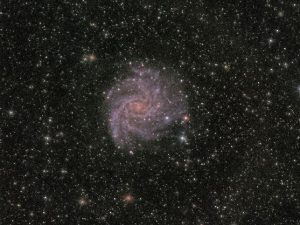
The Fireworks Galaxy, also known as NGC 6946, is a face on intermediate spiral galaxy with a small bright nucleus, whose location in the sky straddles the boundary between the northern constellations of Cepheus and Cygnus. Its distance from Earth is about 25.2 million lightyears. It was once considered to be part of the local group but is now known to be among the dozen bright spiral galaxies near the Milky Way but beyond the confines of the Local Group. Discovered by William herschel on 9 September 1798, this well-studied galaxy has a diameter of approximately 40,000 lightyears.
Pinwheel
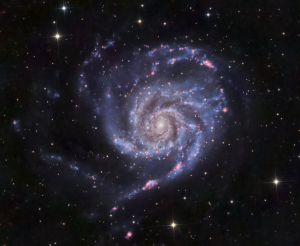
The Pinwheel Galaxy, also known as M101, is in the constellation Ursa Major. It is estimated to be about 21 million light years from earth. The Pinwheel Galaxy is one of the closest galaxies to earth and is about twice the size of the Milky Way. The Pinwheel Galaxy was discovered in 1781 by the French astronomer Pierre Méchain, between the years 1779 and 1782 he not only discovered the Pinwheel Galaxy but also many globular bodies and eight comets.
Whirlpool
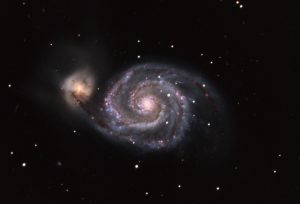
The Whirlpool Galaxy also known as M51, is in the Canes Venatici constellation and is around 23 million light years away from Earth. Charles Messier was the first to discover the Whirlpool Galaxy, which he made in 1773 when charting the night skies on a quest for objects that others might assume were comets. Willian Parsons, an Irish astronomer working at Birr Castle, was the first to discover the spiral nature of the galaxy, as well as the remnants of the dwarf galaxy neighbor. The two galaxies are slowly merging together and the process is well underway. The original shape of the dwarf galaxy is no longer obvious and both spiral arms of the Whirlpool Galaxy have been misshapen by the event. The merger has sparked a burst of star production in the center of the galaxy since the dwarf galaxy is supplying a vast amount of raw material. At the heart of the Whirlpool Galaxy is a supermassive black hole similar to the one found at the center of the Milky Way.
Bodes And Cigar
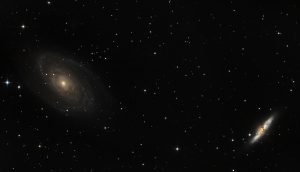
Bodes and Cigar Galaxies, also known as M81 and M82, are a pair of galaxies in the constellation Ursa Major. The pair are located approximately 10 degrees northwest of the “Big Dipper” pointer star Dubhe. The apparent separation of the galaxies is 31 arc-minutes but at a distance of 12 million light-years, their actual distances from each other is 150,000 light years. They are the largest members of the M81 group, a physical association of 34 galaxies.
M81 is a spiral galaxy and was actually discovered by J. E. Bode in 1774. According to Stoyan et al, the distance of M81 is 11.8 million light years and its diameter is 92,000 light years. M82 is a starburst galaxy and has an apparent visual magnitude of 8.4 and its angular diameter is 9×4 arc-minutes. M82 lies at an estimated distance of 12 million light years.
Needle
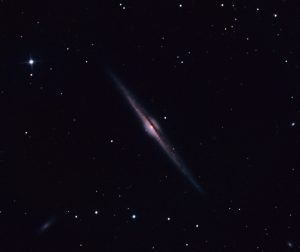
The Needle Galaxy, also known as NGC 4565, is an edge on spiral galaxy, about 30 to 50 million lightyears away in the constellation Coma Berenices. It is known as the Needle Galaxy for its narrow profile. First recorded in 1785 by William Herschel, it is a prominent example of an edge-on spiral galaxy. The Needle, is a giant spiral galaxy more luminous than Andromeda. Much speculation exists in literature as to the nature of the central bulge. In the absence of clear-cut dynamical data on the motions of stars in the bulge, the photometric data alone cannot adjudge among various options put forth. The Needle has at least two satellite galaxies, one of which is interacting with it.
Sunflower
The Sunflower Galaxy also known as M63, is a spiral galaxy in the northern constellation of Canes Venatici and is around 29.3 million lightyears away from Earth. M63 was first discovered by the French astronomer Pierre Michain then later verified by his colleague Charles Messier on June 14, 1779. The galaxy became listed as object 63 in the Messier catalogue In the mid-19th century, Anglo-Irish astronomer Lord Rosse, identified spiral structures within the galaxy, making this one of the first galaxies in which such structure was identified.
Heron
The Heron Galaxy, also known as NGC 5395 / 5394, is an interacting spiral galaxy, located at a distance of 160 million light years, but receding away from the earth at 2181.6 miles per second, in the constellation Canes Venatici. It was discovered by William Herschel on May 16, 1787. NGC 5395 and NGC 5394 are included in the Atlas of peculiar galaxies as Arp 84 in the category “Spiral galaxies with large high surface brightness companions”. NGC 5395 is the larger spiral galaxy interacting with the smaller barred spiral galaxy, NGC 5394. NGC 5395 is nearly face-on, with a diameter of around 140,000 light-years across and has a bright central region and is distorted due to the interaction with NGC 5394. NGC 5394 has an oval disk, with a diameter of around 90 thousand light years across. It is also located at a distance of 160 million light-years across but receding away from the earth at a distance of 2142.4 miles per second.
Sombrero
The Sombrero Galaxy, also known as M104, is one of the more unusual-looking barred spiral galaxies and owes its name to its resemblance to the Mexican hat. The galaxy’s appearance is due to us seeing it “edge” on. The Sombrero Galaxy is classed as an unbarred spiral galaxy and can be found in the constellation of Virgo. It’s estimated distance from Earth is 29 million light years. It was formally added to the Messier Catalogue in 1921. William Herschel (1738-1822) and Charles Messier (1730-1817) were among the first astronomers to describe it.
Whale
The Whale Galaxy, also known as NGC 4631, is a barred spiral galaxy in the Canes Venatici constellation. This galaxy’s slightly distorted wedge shape gives it the appearance of a whale, hence its name. Because this nearby galaxy is seen edge-on from Earth, professional astronomers observe this galaxy to better understand the gas and stars located outside the plane of the galaxy.
Black Holes
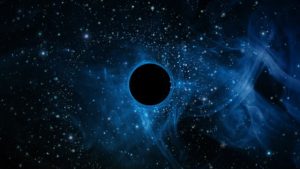
Black holes are both strange and amazing. The study of them has kept scientists busy and excited for the past century. They are an area of space that nothing can escape from once it has entered it, not even light. The ability to absorb all light around them and the way they reflect none of it is why they are referred to as “black.” Astronomers have found evidence of black holes in lots of places in the observable universe and a special type of black hole, supermassive black holes, in the center of almost every galaxy, even our own. Our galaxy contains many less massive black holes, which are the result of stars reaching the ends of their lives and going through a special process.
Now have a go at all our puzzles and see how much you’ve really learnt!…
(Answers at the bottom but no cheating!)
